On the way to another Grand Slam… but what are Wales actually good at?

Wags, wise-crackers and Wales supporters will tell you that scorelines are the only numbers that truly matter in sport.
If Wayne Pivac’s team beat Italy and France to complete a Grand Slam, their slices of fortune over the past month will be forgotten soon enough. It would be a fifth clean-sweep of the Six Nations era for Wales. France have three, with England and Ireland on two each over the same period.
Digging into some other statistics serves to reinforce how strange a tournament this has been so far. Wales have the worst lineout success rate on their own throw (86 per cent) and the second worst scrum success rate on their own put-in (91 per cent).
They have accumulated the fewest carries per game (89.7), the fewest metres (222.3 per game) as well as creating the fewest clean breaks (4.7 per game) and beating fewer defenders than any other side (11 per game).
With that in mind, then, how do you rationalise their success beyond the facts that their first two opponents suffered red cards and that Wales were awarded two controversial tries against England?
Is it still better to be without the ball?
In general, referees around the world do seem to be doing their best to reward teams that attempt to generate and use quick ball. This would represent a shift away from the period between 2018 and 2020, when kicking and aggressive defence – over the ground and at the breakdown – were so valuable.
That said, Wales are demonstrating the lingering value of doggedness and off-the-ball organisation. We will come to Pivac’s proactivity later, but his decision to replace defence coach Byron Hayward with Gethin Jenkins last November already looks inspired.
Wales have made more tackles than any other Six Nations side, at an average of 178.3 per game so far. Jenkins has confirmed that they do not want to absorb so much pressure in every match. However, there is a rare resilience about Wales.
Justin Tipuric’s 84th-minute cover tackle on Ireland centre Garry Ringrose was special. Track, Owen Watkin (13) here following Finn Russell’s late offload at Murrayfield.
He chases down Duhan van der Merwe and makes a tap-tackle that leads to an error from Stuart Hogg. Liam Williams was on hand to drag down Hogg if the pass had stuck:
Now, these are just two of the 535 tackles Wales have completed this Championship. It is difficult for outsiders to make an accurate judgement on the cardiovascular fitness levels of the squad. Harder still would be to quantify players’ desire. But things look promising, and there is evidently trust there.
Only France, whose territorial strategy is well known, have kicked a higher portion of their possession than Wales this Six Nations:
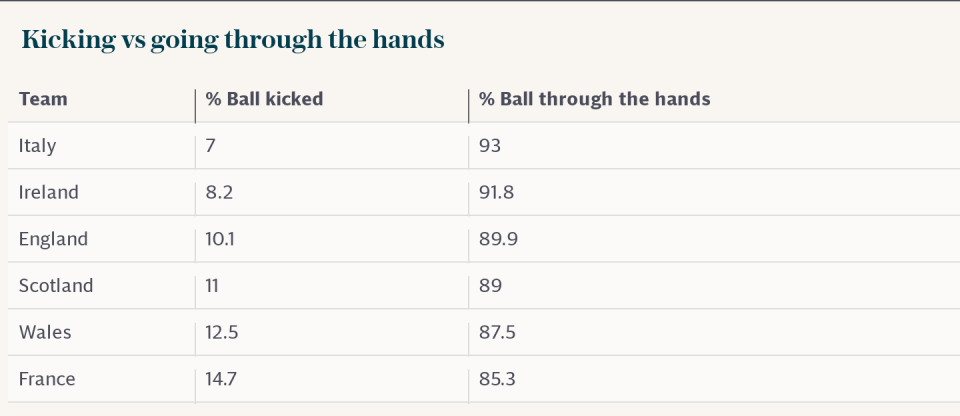
Breakdown spoiling and grapple tackling are strengths that have crossed over from the Shaun Edwards regime. Peter O’Mahony and Zander Fagerson were both dismissed for reckless clear-outs, on Tomas Francis and Wyn Jones respectively.
Wales are awkward to play against, particularly around the ruck area, and it is not a huge surprise that opponents have lost their composure. All the while, the attacking improvements expected under Pivac are coming – albeit in a gradual manner.
Clinical yet controlled attack
After three games, and with a trip to Rome next, Wales have already scored the same number of tries (10) as they did during the 2019 Grand Slam effort.
Their average number of points per visit to the opposition 22 (3.7) is the highest in the tournament, while only France (1.3) have conceded fewer points from opponents’ visits to the 22. Wales’ conversion of clean breaks is also the best, according to Opta:
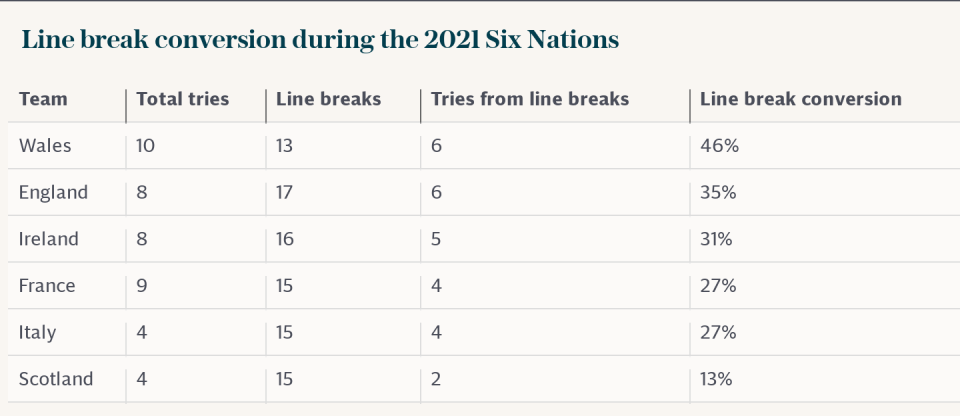
The razor-sharp finishing instincts, and lightning pace, of Louis Rees-Zammit obviously boost those figures. He has three five-pointers thus far. Two more intangible qualities across the squad – sound decision-making and opportunism – have also proved telling.
Without wishing to prise open Pandora’s box again, Dan Biggar, Liam Williams and Josh Adams showed great alertness and conviction to fashion a try from a quickly-taken penalty against England. Kieran Hardy’s tap and snipe was similarly snappy.
So far, Wales seem to be striking an effective balance between throwing ambitious passes and using the boot. Take this sequence from Murrayfield.
Replacement tighthead prop Leon Brown plays a pull-back to Watkin, who squeezes between two tacklers before lifting the ball back to Brown. A trundle and an offload to Wyn Jones sweep Wales in behind Scotland:
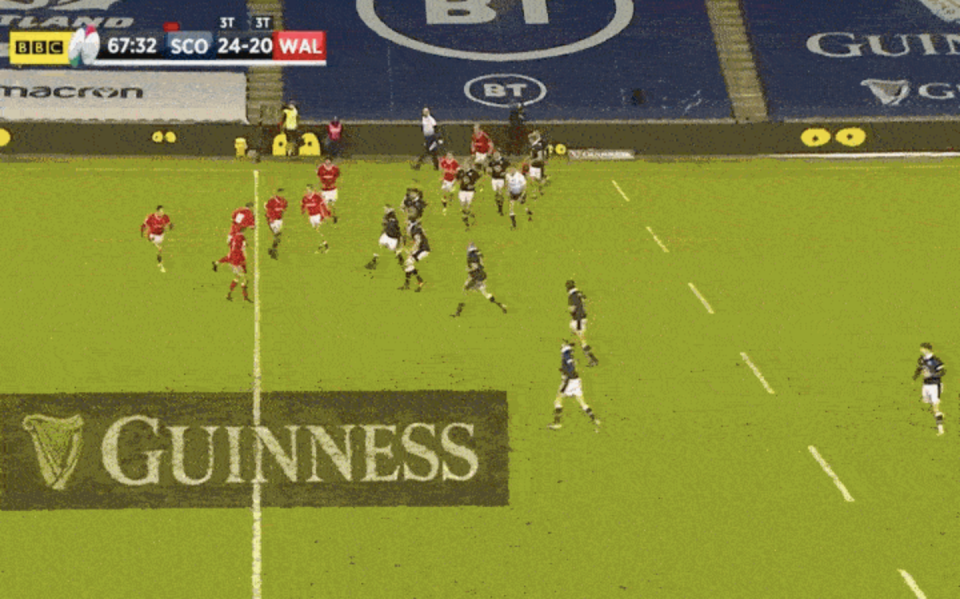
On the following phase, the visitors have plenty of men towards the far touchline. Callum Sheedy does not force a looped pass that could be intercepted, though. Instead, he threads through a grubber for Rees-Zammit to chase:
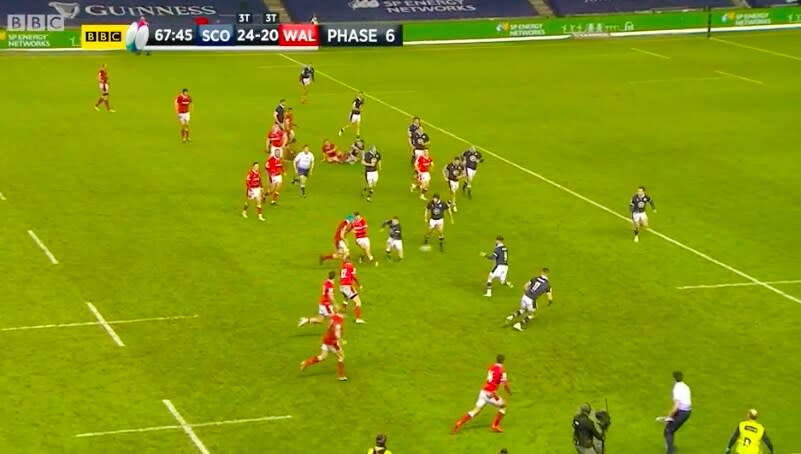
Wales are averaging the fewest offload attempts per match (4.3), which is partly down to their lack of possession. But that has also allowed their average number of turnovers conceded (10.7 per match) to be the lowest across the Championship.
Generally, they have not made themselves vulnerable with mistakes in their own half. That tends to go a long way.
Proactive Pivac
The first replacement of Wales’ Six Nations campaign was a forced one. After starting with a number of trademark chop-tackles, Dan Lydiate’s first Test appearance in two and a half years was derailed by a knee injury and lasted only 13 minutes.
Neither Johnny Williams nor Tomos Williams reached the second half of a bruising match. From there, though, Pivac’s use of his bench has been clear-headed and influential. Only Italy’s replacements have racked up more minutes:
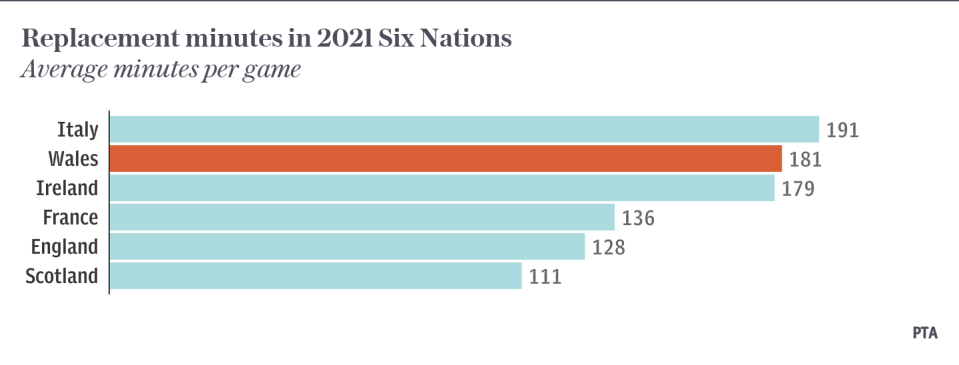
His switching of half-backs Gareth Davies and Biggar for Hardy and Sheedy against Scotland, with over half an hour remaining, underlined that Pivac will not be constrained by reputations. Willis Halaholo also shone after replacing Leigh Halfpenny. That required a back-three revamp, and Wales adapted well.
A fortnight later, Pivac’s reinforcements snuffed out England. Sheedy kicked the goals. Cory Hill shored up the lineout and scored a try. Elliot Dee was excellent. Halaholo completed a perfect lasso tackle on Henry Slade:

During the Gatland years, Wales thrived off momentum. The last leg of their tournament, at the Stade de France, looks a very tough one – not least because they were spanked 38-21 there as recently as October.
But this is a steelier, more settled Wales. Should they beat Italy to set up a Grand Slam opportunity, their self-belief – that crucial intangible – will swell.
Watch: Lunchtime Lessons - Stretch out your stress with our easy desktop yoga home workout

